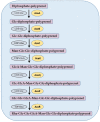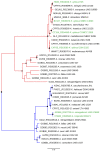Acetan and Acetan-Like Polysaccharides: Genetics, Biosynthesis, Structure, and Viscoelasticity
- PMID: 33799945
- PMCID: PMC7961339
- DOI: 10.3390/polym13050815
Acetan and Acetan-Like Polysaccharides: Genetics, Biosynthesis, Structure, and Viscoelasticity
Abstract
Bacteria produce a variety of multifunctional polysaccharides, including structural, intracellular, and extracellular polysaccharides. They are attractive for the industrial sector due to their natural origin, sustainability, biodegradability, low toxicity, stability, unique viscoelastic properties, stable cost, and supply. When incorporated into different matrices, they may control emulsification, stabilization, crystallization, water release, and encapsulation. Acetan is an important extracellular water-soluble polysaccharide produced mainly by bacterial species of the genera Komagataeibacter and Acetobacter. Since its original description in Komagataeibacter xylinus, acetan-like polysaccharides have also been described in other species of acetic acid bacteria. Our knowledge on chemical composition of different acetan-like polysaccharides, their viscoelasticity, and the genetic basis for their production has expanded during the last years. Here, we review data on acetan biosynthesis, its molecular structure, genetic organization, and mechanical properties. In addition, we have performed an extended bioinformatic analysis on acetan-like polysaccharide genetic clusters in the genomes of Komagataeibacter and Acetobacter species. The analysis revealed for the first time a second acetan-like polysaccharide genetic cluster, that is widespread in both genera. All species of the Komagataeibacter possess at least one acetan genetic cluster, while it is present in only one third of the Acetobacter species surveyed.
Keywords: Acetobacter; Komagataeibacter; acetan; acetan genetic cluster; acetan structure; acetan synthesis; acetan viscoelasticity; acetan-like polysaccharide; acetan-like polysaccharide genetic cluster; applications of acetan; extracellular polysaccharide.
Conflict of interest statement
The authors declare no conflict of interest.
Figures






References
-
- Couso R.O., Ielpi L., Dankert M.A. A Xanthan-gum-like Polysaccharide from Acetobacter xylinum. J. Gen. Microbiol. 1987;133:2123–2135. doi: 10.1099/00221287-133-8-2123. - DOI
-
- Fang L., Catchmark J.M. Characterization of water-soluble exopolysaccharides from Gluconacetobacter xylinus and their impacts on bacterial cellulose crystallization and ribbon assembly. Cellulose. 2014;21:3965–3978. doi: 10.1007/s10570-014-0443-8. - DOI
Publication types
LinkOut - more resources
Full Text Sources
Other Literature Sources
Molecular Biology Databases

